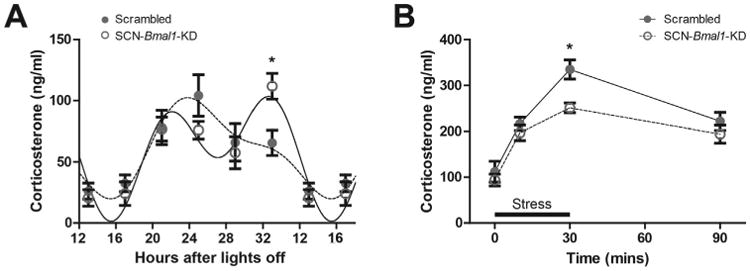Figure 4.

Suprachiasmatic nucleus–specific Bmal1-knockdown (SCN-Bmal1-KD) mice have altered stress hormone function. (A) Circadian patterns of corticosterone release in SCN-Bmal1-KD and control mice kept in constant darkness. In addition to the normal increase of corticosterone at the beginning of the subjective night (25 hours after “lights off”), SCN-Bmal1-KD mice have a second corticosterone peak at the end of subjective night (33 hours after “lights off”). Data are shown as mean ± SEM and Fourier-curve fits with two harmonics; interaction, F5,70 = 3.279, p = .0102; stress, F1,70 = 18.45, p ≤ .0001; genotype, F5,70 = 0.01066, p = .9192; post hoc test, *p ≤ .05 (two-way repeated measures analysis of variance with Bonferroni posttest); n = 8. (B) Corticosterone release of SCN-Bmal1-KD and control mice in response to acute restraint stress for 30 minutes. SCN-Bmal1-KD mice show an attenuated corticosterone increase. Data are shown as mean ± SEM; interaction, F3,39 = 1.23, p = .3101; stress, F1,39 = 38.45, p ≤ .0001; genotype, F3,39 = 6.500, p = .0242; post hoc test, *p ≤ .05 (two-way repeated measures analysis of variance with Bonferroni posttest); n = 7–8.
